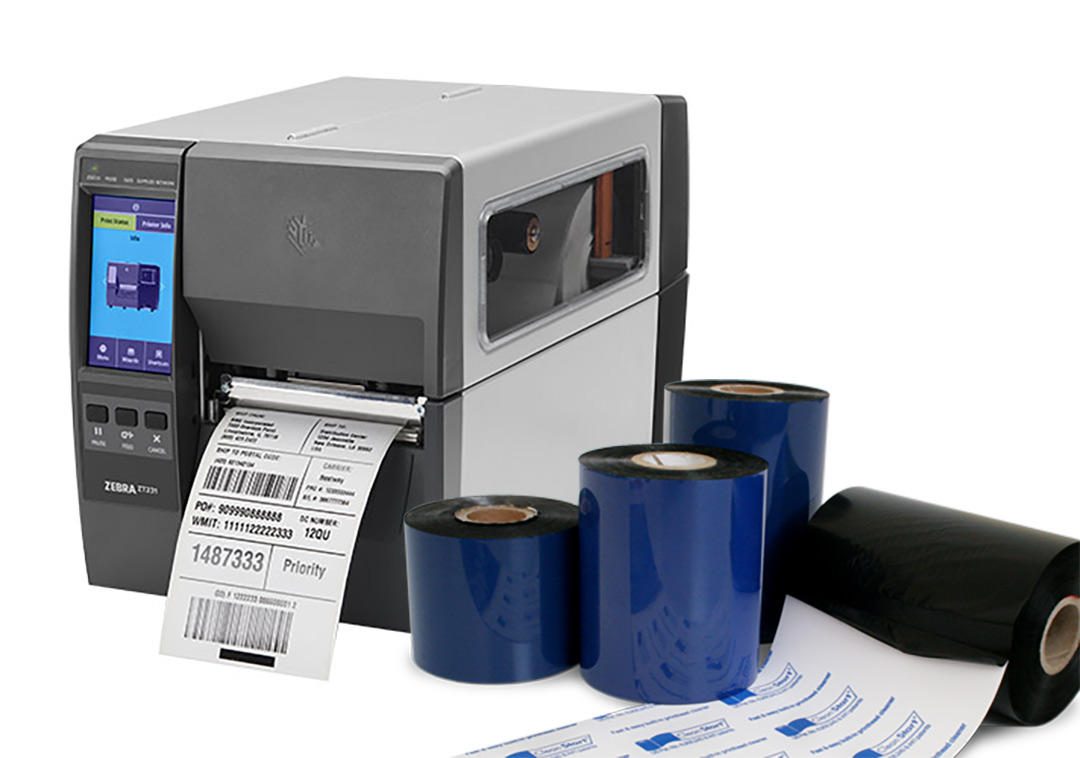Blog
What Is a Thermal Transfer Ribbon and How Does It Work?
The selection of printing methods in labeling environments has a significant impact on operational performance and cost-efficiency while ensuring regulatory compliance. Thermal transfer ribbons stand out as the preferred choice for producing long-lasting high-resolution labels across multiple industries.
Professionals in distribution, sourcing management, or label system integration need to understand thermal transfer ribbon operations alongside available options and matching capabilities for materials and environments to achieve the best print quality and durability.
This comprehensive guide details all essential information about thermal transfer ribbons through explanations of their operation, formulations and technical characteristics as well as their applications and recommendations for bulk purchasing.
What Is a Thermal Transfer Ribbon?
Thermal transfer printing systems employ rolls of ink-coated film known as thermal transfer ribbons. The printer’s thermal printhead heat triggers the transfer of ink from the ribbon onto the label surface which produces a long-lasting smudge-resistant image or barcode.
Applications that need high-definition barcodes along with chemical resistance and long-term durability demand thermal transfer ribbons.
- High-definition barcodes
- Chemical resistance
- Long-term durability
- Sharp logos and serialized data
Key Components of a Ribbon:
- Base film (usually polyester)
- Release layer
- Ink layer (wax, wax-resin, or resin)
How Does a Thermal Transfer Ribbon Work?
- A compatible thermal transfer printer receives the ribbon during setup.
- The printer’s printhead selectively heats designated sections of the ribbon.
- The label substrate receives melted ink which permanently bonds to its surface from the ribbon.
- The image cools instantly and becomes smudge-proof.
This method produces a print that combines superior quality and durability which makes it perfect for applications in logistics and manufacturing as well as compliance labeling.
Benefits of Using Thermal Transfer Ribbons
1. Superior Print Durability
- The print withstands exposure to moisture, oils, UV light and abrasion.
- Suitable for long-term or outdoor labeling
2. Sharp, High-Definition Prints
- Crisp barcodes and small fonts
- Thermal transfer ribbons are compatible with printers that operate at 203 DPI, 300 DPI and 600 DPI resolutions.
3. Versatility
- These ribbons can produce prints on different materials such as paper and various plastics.
- Paper
- Polypropylene (PP)
- Polyethylene (PE)
- Polyester (PET)
4. Better Compliance
- Meets global label standards for:
- GHS (Globally Harmonized System)
- FDA packaging rules
- Cold chain and logistics
5. Extended Printhead Life
- Using ribbons extends printer life because they decrease friction unlike direct thermal printing.
Types of Thermal Transfer Ribbons
1. Wax Ribbons
- Least expensive
- Best for uncoated paper labels
- Moderate resistance to smudging
- Wax Ribbons work best for shipping labels, retail product tags and basic inventory identification.
2. Wax-Resin Ribbons
- Blend of wax and resin
- Improved durability and scratch resistance
- Compatible with coated paper and synthetics
- Common in food, beverage, and logistics labeling
3. Resin Ribbons
- Highest durability and chemical resistance
- Designed for synthetic labels
- This ribbon type is best used in demanding environments like pharmaceutical applications, automotive production areas and laboratories.
Understanding Ribbon Specifications
| Parameter | Description |
|---|---|
| Width | 33mm to 220mm+ |
| Length | 74m (desktop) to 600m+ (industrial) |
| Core Size | 0.5″, 1″, 1.5″ |
| Winding | Coated Side Out (CSO) / Coated Side In (CSI) |
| Color Options | Black (standard), Red, Blue, White, Green |
Choosing the Right Ribbon Width:
- Select a ribbon width that is either equivalent to or exceeds your label dimensions.
Selecting Wind Direction:
- Based on printer model requirements
- CSI for flat head printers
- CSO for near-edge printers
Where Are Thermal Transfer Ribbons Used?
Logistics & Warehousing
- Shipping labels
- Pallet ID labels
- Inventory tracking tags
Retail
- Price tags
- SKU labels
- Product barcodes
Κατασκευή
- Asset tracking
- Safety labels
- Work-in-process labels
Pharmaceuticals & Chemicals
- GHS-compliant labels
- Specimen tracking
- Lab sample labeling
Food & Beverage
- Cold chain labels
- Expiry date labeling
- Nutritional information panels
Electronics & Automotive
- Component ID
- Warranty labels
- Anti-counterfeit coding

Selecting the correct thermal transfer ribbon requires careful consideration of several factors
Step 1: Know Your Label Material
- Paper: Use wax or wax-resin
- Coated Paper/PP: Use wax-resin
- PET or Synthetic: Use resin
Step 2: Evaluate Environment
- The environmental conditions including temperature variations and humidity levels plus exposure to chemicals and UV light affect thermal transfer ribbon performance.
- Choose durability accordingly
Step 3: Determine Print Volume
- For high-volume industrial use: 300m–600m ribbons
- For desktop use: 74m–110m ribbons
Step 4: Match Ribbon to Printer Specs
- Printer brand and model
- Core diameter and width
- Wind direction
Bulk Ordering and Procurement Tips
1. Sample Testing
To ensure proper compatibility test your labels and printers by ordering sample rolls.
2. Understand MOQ & Packaging
- Manufacturers typically begin their minimum order quantity at between 500 to 1000 rolls.
- Private label and branded packaging options available
3. Evaluate Compliance
- RoHS, REACH, GHS, ISO-certified sourcing
4. Plan Based on Forecast
- Planning your usage on an annual or quarterly basis enables you to achieve better pricing and supply reliability.
5. Storage & Shelf Life
- Store ribbons in cool, dry environments
- Typical shelf life: 12–24 months
Conclusion
Thermal transfer ribbons serve as fundamental elements for current labeling systems due to their ability to provide lasting performance alongside sharp print details and extensive compatibility with different materials. The appropriate ribbon selection for B2B use cases including industrial logistics and healthcare ensures operational efficiency alongside compliance and durable label performance.
Optimizing your supply chain and exceeding customer expectations requires knowledge of ribbon types, specs, and sourcing strategies whether you need wax ribbons for inventory labels or durable resin ribbons for extreme environments.




FAQs
Can I use thermal transfer ribbons on any label?
No. Ribbon selection depends on your label material. Wax works on paper; resin is for synthetics.
How long do printed thermal transfer labels last?
With the right ribbon and label material, prints can last for years—even in outdoor or chemical-exposed environments.
Do thermal transfer ribbons work in color?
Yes. Color ribbons (red, blue, green, white, silver) are available for branding or regulatory use.
How do I know what core size and wind direction I need?
Check your printer’s specs or current ribbon configuration. Core size and wind affect printer compatibility.
Are thermal transfer ribbons recyclable?
The polyester film is not widely recyclable, but some suppliers offer eco-friendly alternatives or recycling programs.

